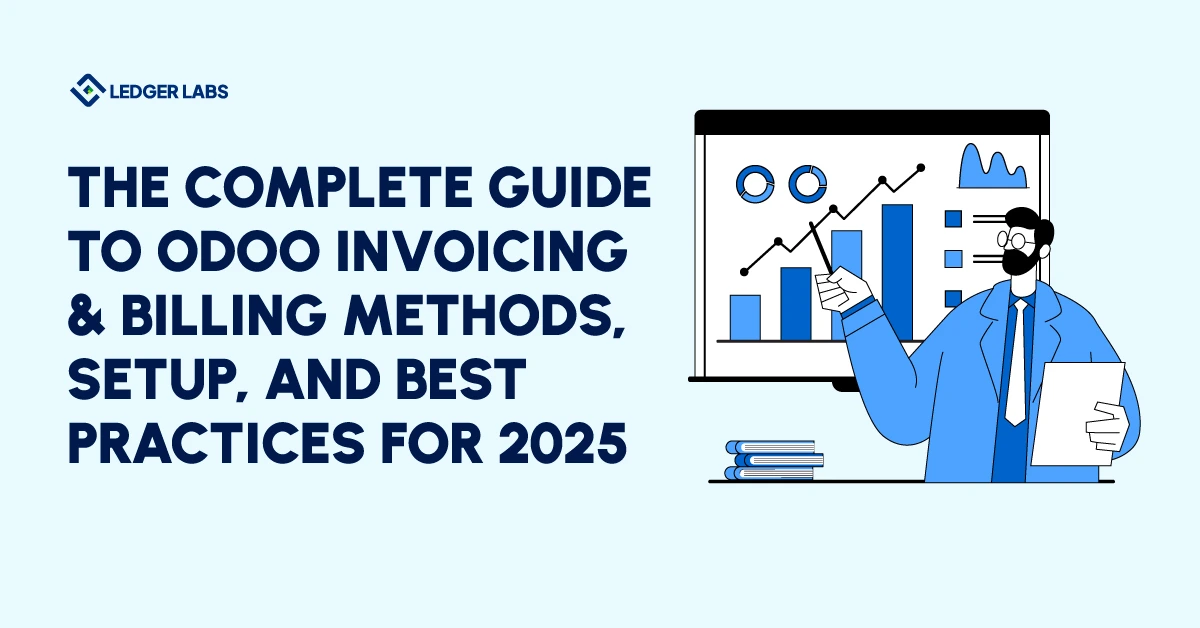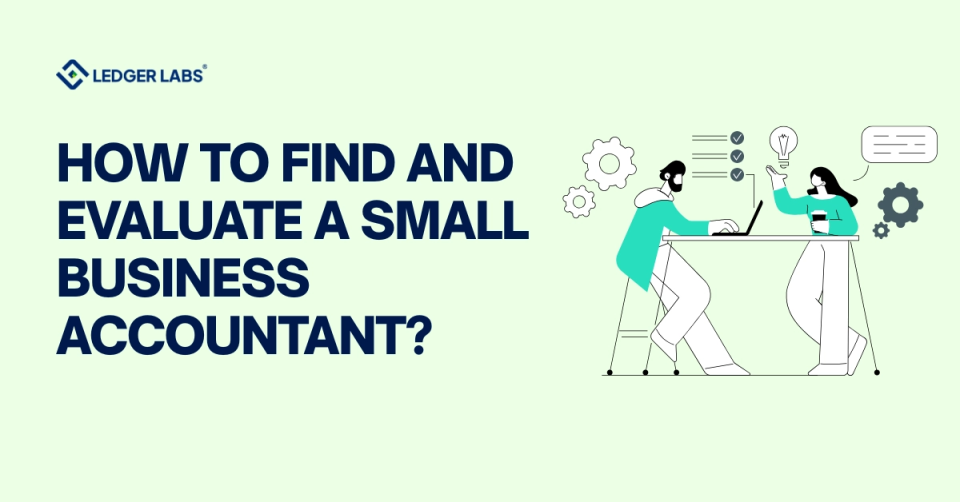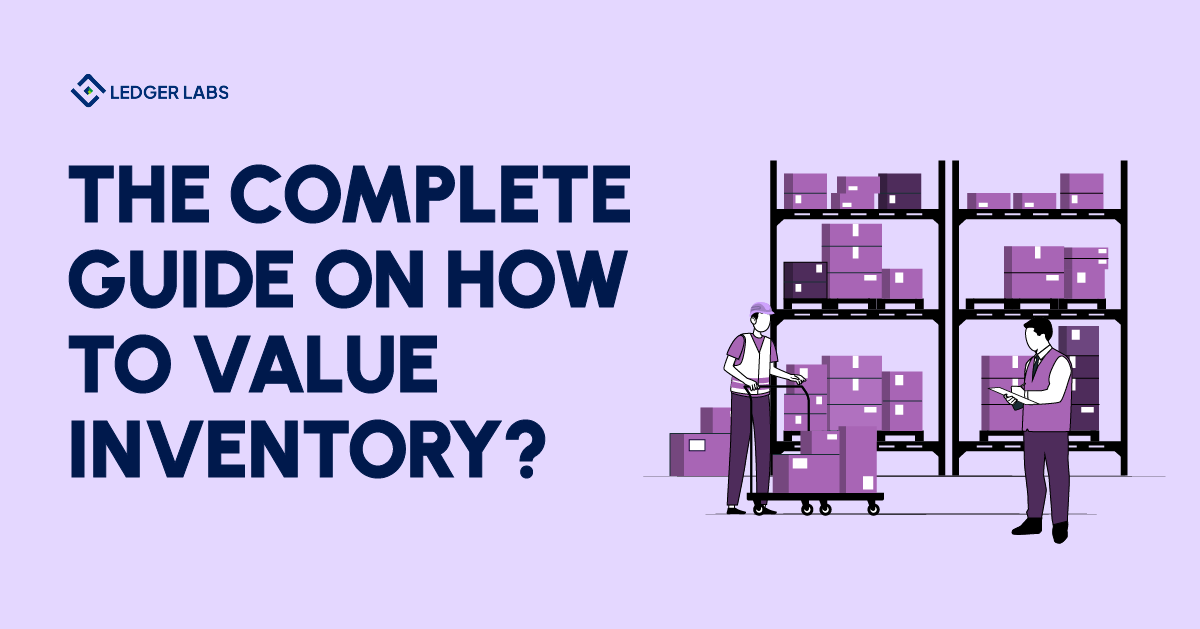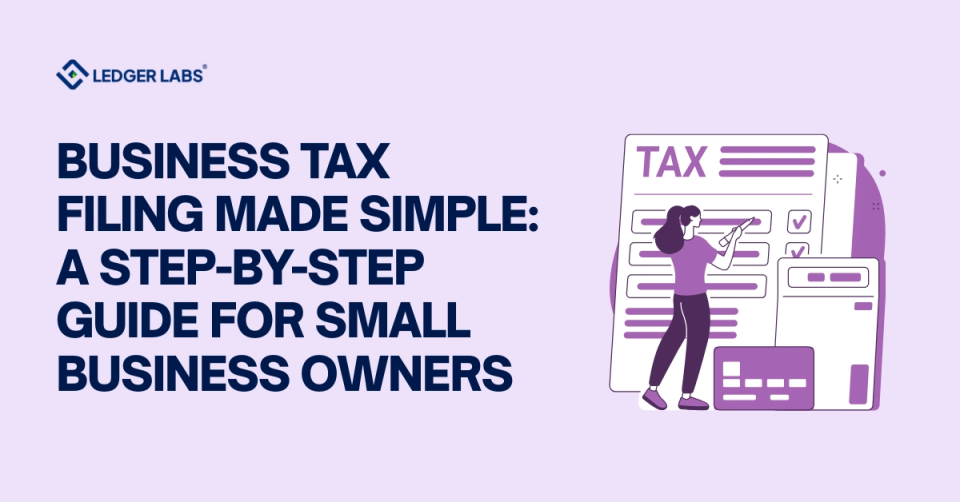About 62% of invoices are paid late, costing small businesses an average of $84,000 annually in delayed cash flow.
If you’re using Odoo but still drowning in invoice chaos, you’re not alone – and you’re leaving serious automation power on the table.
With invoicing errors costing businesses up to 3% of annual revenue and the shift toward real-time financial visibility accelerating, mastering Odoo Invoicing & Billing is no longer optional.
This Odoo bookkeeping guide walks you through choosing the right invoicing method for your business model, setting up automation that cuts processing time by 75%, and implementing best practices that get you paid faster.
Key Takeaways
- Late payments are a major cost driver – 62% of invoices are paid late, costing small businesses an average of $84,000 annually. Odoo Invoicing reduces these delays with automation.
- Odoo supports six invoicing methods (manual, timesheet-based, milestone, subscription, delivered quantity, and eCommerce), each tailored to different business models. Picking the wrong one can cost 20+ hours a month in manual corrections.
- Automation saves time and prevents errors – Automated invoice generation, payment reminders, and bank reconciliation cut processing time by up to 75%, saving businesses 10+ hours per month.
- Best practices prevent recurring issues – Clean customer data, smart payment terms, consistent reconciliation, and professional invoice templates reduce disputes, speed up payments, and strengthen client trust.
- Odoo stands out against competitors — Unlike QuickBooks, Xero, or FreshBooks, Odoo combines invoicing with a full ERP system, supports six billing methods, and offers deeper automation and customization options.
What Is Odoo Invoicing & Billing?
Ever wonder why some businesses get paid in 15 days while others chase invoices for 60+ days? The difference often comes down to their Odoo billing system and how well it’s configured.
Odoo Invoicing & Billing is an integrated financial management module that automates invoice creation, payment processing, and account reconciliation within the Odoo ERP platform.
Here’s what makes this module powerful for day-to-day operations:
- Automated invoice generation from sales orders — No more manual data entry or copy-paste errors
- Multiple invoicing policies — Bill for ordered quantities upfront or delivered quantities after fulfillment
- Payment gateway integration — Accept payments via Stripe, PayPal, Authorize.net, and 30+ other processors
- Multi-currency support — Invoice international clients in their local currency with automatic conversion
- Automated follow-ups and reminders — Send payment reminders automatically when invoices hit certain overdue thresholds
- Real-time reconciliation — Match incoming payments to open invoices instantly, keeping your Accounts Receivable (AR) clean
Who Actually Needs This?
- Small businesses use Odoo to eliminate manual invoice creation.
- Mid-sized companies use it to enforce consistent billing policies across teams.
- Enterprises use it to manage complex multi-currency, multi-entity billing scenarios.
Most consulting firms cut invoice processing time from 45 minutes to 3 minutes per client with the help of Odoo.
eCommerce brands eliminate payment reconciliation backlogs entirely.
Construction companies track milestone billing across 50+ active projects without spreadsheets.
The common thread? They stopped treating invoicing as an admin task and started treating it as an automated system. If you’re still manually creating invoices in Odoo or using external tools because “it’s faster,” you’re missing the point—and losing hours every week.
6 Odoo Invoicing Methods: Which Is Right for Your Business?
Here’s the reality: choosing the wrong invoicing method costs businesses 20+ hours monthly in manual corrections, reconciliation headaches, and customer disputes.
I’ve watched companies try to force subscription billing into a project-based workflow, or use fixed-price invoicing for variable quantities. It always ends the same way – frustrated teams and delayed payments.
Odoo gives you 6 different Odoo invoicing methods because different business models need different Odoo invoice workflows. A SaaS company billing monthly subscriptions has completely different needs than a construction firm tracking project milestones or a wholesale distributor shipping variable quantities.
How to Choose Your Method
Here’s a comparison table to help you match your business model to the right approach:
Common Service Packages:
| Method | Best For | Setup Complexity | Automation Level | Ideal Business Size |
|---|---|---|---|---|
| Manual (Fixed Price) | Product sales, fixed pricing | Low | Low | All sizes |
| Timesheet-Based | Hourly services, consulting | Medium | Medium | Small to Medium |
| Milestone-Based | Long-term projects | Medium | Medium | Medium to Large |
| Subscription | Recurring services, SaaS | Low | High | All sizes |
| Delivered Quantity | Variable quantities, bulk orders | Medium | Medium | Small to Large |
| eCommerce | Online sales, retail | Medium | High | All sizes |
The decision comes down to three questions:
- When do you know the final billable amount? (Upfront vs. after delivery)?
- How often do you bill the same customer? (One-time vs. recurring)?
- Does your pricing change based on what you actually deliver? (Fixed vs. variable)?
Your invoicing method should match when money changes hands in your business, not when it’s convenient to send an invoice. Get this right, and billing becomes automatic. Get it wrong, and you’re constantly creating manual adjustments and credits.
Here’s each method with detailed setup instructions so you can implement the one that fits your business:
Method 1 - Manual Invoicing (Fixed Price)
Let’s start with the most straightforward method.
Manual invoicing with fixed pricing means you bill a set amount for products or services, regardless of what happens during delivery. You’re charging $500 for that website redesign?
Invoice shows $500. Selling 100 units at $10 each? Invoice shows $1,000. No surprises, no calculations mid-process.
Who Should Use Fixed-Price Invoicing?
This method works perfectly for:
- eCommerce product sales — You sell a laptop for $899, you invoice $899
- Wholesale distributors — Fixed per-unit pricing with volume discounts
Fixed-price service packages — Marketing packages, maintenance contracts, consulting retainers
Your Two Policy Options
When you’re learning to create invoices in Odoo, you’ll choose between two triggers:
- Ordered Quantities: Odoo generates the invoice the moment your customer confirms the sales order. Fast cash flow, but risky if you can’t deliver everything.
- Delivered Quantities: Invoice only after you validate the delivery order. Slower payment, but you’re only billing for what actually shipped.
Setting Up Fixed-Price Invoicing (5 Steps)
- Navigate to Product → Invoicing Policy in your product settings
- Select either “Ordered quantities” or “Delivered quantities” based on your cash flow needs
- Configure your pricing rules (fixed price, volume discounts, customer-specific pricing)
- Set up invoice template customization with your branding, payment terms, and bank details
- Test with a sample sales order to confirm invoices are generated correctly
Pros & Cons You Need to Know
Pros: Dead simple to implement. Your customers see clear pricing upfront. Your team needs almost zero training for Odoo invoice generation.
Cons: Every invoice requires manual action—you’re clicking “Create Invoice” on every sales order. Not ideal for variable pricing scenarios or partial shipments.
But what if you bill by the hour instead of by the product? That’s where timesheet-based invoicing comes in.
Method 2 - Timesheet-Based Invoicing
Fixed pricing works great until you start billing by the hour—then manual invoicing becomes a nightmare of spreadsheets and math errors.
Timesheet-based invoicing connects your team’s logged hours directly to customer invoices. Your consultant works 8 hours on Tuesday?
Those 8 hours automatically flow into the invoice at your agreed hourly rate. No manual entry, no forgotten hours, no reconciliation headaches at month-end.
Who Needs Hourly Billing?
This method is perfect for Odoo invoicing for small business service providers:
- Consulting firms — Bill clients for strategy, implementation, or advisory hours
- Law offices — Track billable hours per case or client matter
- Marketing agencies — Charge for creative work, campaign management, media buying hours
- IT service providers — Bill for support tickets, maintenance, and project work
Who Needs Hourly Billing?
This method is perfect for Odoo invoicing for small business service providers:
- Consulting firms — Bill clients for strategy, implementation, or advisory hours
- Law offices — Track billable hours per case or client matter
- Marketing agencies — Charge for creative work, campaign management, media buying hours
- IT service providers — Bill for support tickets, maintenance, and project work
How Timesheet Invoicing Actually Works?
Here’s the flow: Your employees log hours in Odoo Timesheets (either desktop or mobile). Those hours automatically populate the linked sales order. When you’re ready to bill, Odoo generates the invoice based on logged time—no manual calculation needed.
This is Odoo invoice automation at its simplest. You’re not clicking “Create Invoice” and typing numbers. The system does the math.
Setting Up Timesheet Billing (5 Steps)
- Enable the Timesheets app in your Odoo settings
- Create a service product with your hourly rate (e.g., “Consulting Services – $150/hour”)
- Link a project to your sales order so hours flow correctly
- Configure the automatic invoicing trigger (invoice timesheet entries monthly, weekly, or on-demand)
- Set up a review/approval workflow if managers need to validate hours before billing
Why Automation Matters Here?
Manual time tracking and billing reportedly reduces billing errors by 85% compared to spreadsheet-based approaches. You’re capturing hours in real-time instead of trying to remember what you did last Tuesday.
Real-time profitability tracking is the hidden benefit. You can see if a client project is profitable while it’s happening, not three weeks later when the invoice finally goes out.
Pro tip: Use Odoo’s mobile app for on-site time tracking. Field teams reportedly improve time entry accuracy by 40% when they log hours immediately instead of reconstructing their day from memory.
But what if you don’t bill by the hour or by fixed price? What if you invoice based on project completion stages? That’s where milestone billing comes in.
Method 3 - Milestone-Based Invoicing
Hourly billing works until you’re managing a 6-month project—then waiting until completion to invoice kills your cash flow.
Milestone-based invoicing lets you bill at specific project stages instead of waiting until everything’s done. Complete the website design phase? Invoice 30%. Finish development? Invoice another 40%. You’re getting paid as you deliver, not three months after you started.
Who Should Use Milestone Billing?
This method solves cash flow problems for project-based businesses:
- Software development projects — Bill at design, development, testing, and launch phases
- Construction companies — Invoice at foundation, framing, rough-in, and completion stages
- Long-term consulting engagements — Charge for discovery, strategy, implementation, and optimization phases
- Marketing campaigns — Bill at kickoff, creative approval, launch, and performance review milestones
Setting Up Milestone Invoicing (5 Steps)
- Create a service product and set the invoicing policy to “Based on Milestones”
- Define your project milestones with clear deadlines and deliverables
- Link each milestone to specific deliverables your client can verify
- Set automatic or manual invoice triggers (auto-bill when milestone marked complete, or review first)
- Configure payment terms per milestone using Odoo billing features (Net 15, Net 30, or due on receipt)
Why This Method Works?
- Steady cash flow throughout the project: You’re not funding a 6-month engagement out of pocket, waiting for one big payment at the end.
- Client visibility into progress: When clients see invoices tied to completed work, they understand where their money’s going. Odoo invoice tracking shows them exactly which milestones are complete, in progress, or upcoming.
- Reduced payment disputes: It’s harder for clients to dispute payment when you’re invoicing for completed, verified deliverables. The milestone structure creates natural approval checkpoints.
A Common Milestone Structure That Works
Here’s a typical breakdown for invoice payment processing on project work:
- 30% upfront — Project kickoff and discovery phase (secures commitment)
- 30% at mid-point — Design or strategy approval (validates direction)
- 30% at completion — Final delivery and handoff (rewards completion)
- 10% retention — 30 days post-launch (ensures support period coverage)
This structure protects both sides. You’re not carrying all the financial risk, and your client isn’t paying everything upfront for undelivered work.
In short: Milestone-based invoicing breaks large projects into manageable payment stages, keeping your cash flow healthy while giving clients predictable billing tied to real progress. It’s the middle ground between hourly chaos and risky pay-at-the-end arrangements.
But what if your clients pay you every month for the same service? That’s where subscription billing takes over.
Method 4 - Subscription & Recurring Invoicing
Milestone billing works great for one-time projects, but what if you’re billing the same customers every single month?
Subscription invoicing is the ultimate automated invoicing solution—set it once, and Odoo handles billing forever. Your customer signs up for $99/month software access? Odoo automatically generates and sends that invoice on the 1st of every month. No manual work, no forgotten invoices, no “oops, we forgot to bill them in July.”
Who Needs Subscription Billing?
This is the method for predictable, recurring revenue businesses:
- SaaS companies — Monthly or annual software licenses
- Membership organizations — Gym memberships, professional associations, clubs
- Subscription boxes — Monthly product deliveries (coffee, cosmetics, meal kits)
- Maintenance contracts — HVAC service plans, IT support agreements, equipment maintenance
- Software licenses — Per-user licensing for tools, platforms, or services
What Makes Subscription Invoicing Powerful
The Odoo billing module handles complexities you’d never want to manage manually:
- Flexible billing frequencies: Daily, weekly, monthly, quarterly, yearly—whatever matches your business model.
- Automatic invoice generation: Set the schedule once, and invoices go out on time every cycle. Businesses report 99% on-time billing with subscription automation versus manual processes.
- Failed payment retry logic: Card declined? Odoo automatically retries payment and sends dunning emails to recover revenue.
- Proration handling: Customer upgrades mid-month? Odoo calculates the prorated difference automatically.
- Customer self-service portal: Let customers manage their own subscriptions, update payment methods, and view invoice history.
Setting Up Subscription Billing (6 Steps)
- Install the Odoo Subscriptions app (this is an Enterprise feature—more on that below)
- Create your subscription template with pricing tiers and billing frequency
- Configure billing frequency (monthly, yearly, or custom intervals)
- Set up payment gateway integration for automatic charges (Stripe, PayPal, etc.)
- Enable automated payment reminders for upcoming renewals
- Configure dunning management for failed payments (retry schedules, escalation emails)
Important note: Subscription features require Odoo Enterprise ($24/user/month). If you’re on Community Edition, you can use recurring rules as a workaround, but you’ll lose automatic payment processing and customer portal features.
Method 5 - Delivered Quantity Invoicing
Subscription billing assumes you’re delivering the same thing every time, but what if what you ordered isn’t what actually ships?
Delivered quantity invoicing solves a specific problem: billing customers for what they actually receive instead of what they originally ordered. This matters when products have variable weights, volumes, or quantities, resulting in a final delivery amount that differs from the purchase order.
When is Delivered Quantity Invoicing Essential?
This method prevents billing disputes for businesses dealing with:
- Food suppliers — Fresh produce and meat sold by weight (a “10kg box” might weigh 9.8kg or 10.2kg)
- Liquid distributors — Fuel, chemicals, beverages sold by volume
- Bulk material sellers — Gravel, sand, grain, or any commodity measured at delivery
- Partial delivery scenarios — When you can only fulfill 80% of an order due to stock issues
Why This Method Matters?
- Ordered quantity ≠ delivered quantity. You promise 100 units, ship 95 due to quality control, and now you need to adjust the invoice. Without delivered quantity invoicing, you’re manually editing every invoice or dealing with angry customers who got billed for products they never received.
- Customer expectations alignment: Your clients see exactly what arrived on their dock, and your invoice matches. No surprises, no disputes.
- Reduced billing disputes: The invoice tracking system shows precisely what was delivered, validated, and billed. When customers question charges, you point to the validated delivery order.
Setting Up Delivered Quantity Invoicing (5 Steps)
- Set your product’s invoicing policy to “Delivered Quantities” in the product form
- Create and confirm your sales order as normal
- Validate the delivery order (this is where Odoo captures actual delivered amounts)
- Odoo auto-calculates delivered amounts based on validated delivery
- Generate invoice from the delivery order—Odoo invoice generation uses actual quantities, not ordered quantities
The system handles partial deliveries automatically. Ship 50 units today and 50 next week? Two invoices are generated based on each delivery.
Real-World Example
A food distributor receives an order for 100kg of chicken breast at $8/kg ($800 total). At delivery, the actual weight is 97.5kg due to trimming and quality checks.
With delivered quantity invoicing, Odoo generates an invoice for $780 (97.5kg × $8), not the original $800. The customer pays for exactly what they received. No manual adjustment, no refund processing, no dispute.
Method 6 - eCommerce Invoicing
Delivered quantity invoicing works for physical shipments, but what about customers checking out online at 2 AM?
Odoo eCommerce invoicing handles the entire payment-to-invoice process automatically while you sleep. Customer adds items to cart, pays with their credit card, and Odoo instantly generates the invoice, sends the receipt, and updates your accounting—all before they close their browser.
This is online invoicing at full automation. You’re not manually creating invoices for every website order. The system handles everything from payment gateway integration to receipt delivery.
Also Read: Common Errors in Odoo Accounting
Who Needs eCommerce Invoicing?
This method is built for businesses selling online:
- Online retailers — Selling physical products through your website
- Dropshipping businesses — No inventory, just order fulfillment and customer billing
- Digital product sellers — Software downloads, courses, templates, ebooks
- Multi-channel sellers — Selling on your website, Amazon, eBay simultaneously
What Makes eCommerce Invoicing Different?
- Automatic invoice creation on order completion: The moment payment clears, Odoo generates the invoice. No manual trigger needed.
- Payment gateway sync: Connect Stripe, PayPal, Authorize.net, or 30+ other processors. Odoo invoice payment flows directly into your accounting without manual entry.
- Multi-currency support: Sell to customers in Germany, Japan, and Brazil? Invoice them in Euros, Yen, and Reais automatically.
- Tax calculation automation: Odoo calculates sales tax, VAT, or GST based on customer location and product type. No spreadsheet lookups.
- Digital receipt delivery: Customers get PDF receipts emailed instantly after payment—professional branding included.
Setting Up eCommerce Invoicing (5 Steps)
- Enable the Odoo eCommerce app in your Apps menu
- Configure your payment acquirers (add Stripe API keys, PayPal credentials, etc.)
- Set invoicing triggers to “Invoice when payment is confirmed” (not when order is placed)
- Customize your invoice email templates with your branding and support info
- Enable customer portal access so buyers can download invoices anytime
The Complete Payment Flow
Here’s what happens in 15 seconds: Customer completes checkout → Payment processor confirms transaction → Odoo auto-generates invoice → Receipt emails to customer → Your Accounts Receivable (AR) and revenue accounts update automatically.
Zero manual work. The entire flow from “Add to Cart” to “Books Updated” runs on autopilot.
Pro tip: Set invoicing to trigger after payment confirmation, not at order placement. Otherwise, you’re creating invoices for abandoned carts and failed payments—creating cleanup work later.
How to Set Up Odoo Invoicing? A Step-by-Step Implementation
You’ve chosen your invoicing method—now let’s actually configure it so you can start billing customers today, not next week.
Most people overthink Odoo setup.
They spend hours reading documentation when the core configuration takes 30-45 minutes if you know exactly what to click. Here’s the streamlined path to getting how to create invoices in Odoo working properly.
Initial Configuration (5 Steps)
- Access Settings: Navigate to Accounting/Invoicing → Configuration → Settings. This is your control panel. Enable features you need: customer invoices, vendor bills, payment terms, multi-currency (if selling internationally).
- Configure Company Details: Add your company logo (300x100px PNG works best), full business address, and tax ID. Set your default currency—this affects every invoice you create. Configure Odoo tax rules to ensure the correct tax rates are applied based on your business location and products. You can also configure your fiscal year settings if you operate on a non-calendar year.
- Set Up Payment Terms: Define your standard terms: Net 30 (payment due in 30 days), Net 15, Due on Receipt, or 2/10 Net 30 (2% discount if paid within 10 days). Create custom terms for specific customer types. Set defaults so new customers automatically get your preferred terms.
- Choose Invoice Template: Navigate to Settings → Business Documents. Odoo gives you template options—professional, modern, or basic layouts. Pick one that matches your brand style. You’ll customize it next.
- Enable Customer Portal: Activate portal access so customers can view invoices, download PDFs, and pay online. Configure permissions (what they can see and do). Set up online payment options so they can pay directly from the invoice.
Customizing Invoice Templates
Odoo invoice templates control how your invoices look—and first impressions matter.
- Branding elements: Upload your logo, choose brand colors that match your website, add custom footer text (support email, return policy), and include social media links if relevant.
- Information fields: Configure invoice number format (INV-2025-001 or custom), add payment QR codes for mobile payments, include bank account details for wire transfers, and display terms and conditions.
- Advanced customization: Use Odoo Studio (Enterprise feature) for custom fields. Set conditional display rules (show different text for different customers). Create multi-language templates if you sell internationally.
Integrating Payment Gateways
Odoo invoice customization includes connecting payment processors so customers can pay instantly.
Navigate to Payment Acquirers. Activate your chosen gateway (Stripe is most popular). Enter API credentials from your payment processor account. Configure accepted payment methods (credit card, ACH, digital wallets). Set transaction fee handling (absorb fees or pass to customer). Always test in sandbox mode before going live.
In short: Proper setup means configuring your company details, choosing professional templates, and connecting payment gateways—all doable in under an hour. Get this foundation right, and invoicing becomes a one-click process instead of a daily headache.
Odoo Invoice Automation: Workflows That Save 10+ Hours Weekly
Your invoicing system is set up—but if you’re still manually clicking “Create Invoice” 50 times per week, you’re missing the whole point.
Odoo invoice automation turns repetitive billing tasks into background processes. The difference between spending 10 hours weekly on invoicing versus 45 minutes isn’t working faster—it’s automating the workflows that don’t need human decisions.
7 Automation Workflows Every Business Should Use
- Automatic Invoice Generation from Sales Orders: Sales order confirms → Draft invoice auto-creates. Setup: Sales → Settings → Automatic Invoice Generation. Time saved: 15 minutes per invoice reduced to 2 minutes.
- Scheduled Recurring Invoices: Monthly subscription renewal date hits → Invoice creates and sends automatically. Setup: Subscriptions app or recurring rules. Time saved: 20 minutes monthly per recurring customer.
- Automated Payment Reminders: Invoice hits 7 days overdue → Polite reminder emails automatically. Invoice hits 30 days → Escalated reminder. Setup: Follow-up levels in invoice settings. Result: 35% faster payment collection versus manual reminders.
- Auto-Reconciliation with Bank Feeds: Bank transaction imports → Odoo auto-matches to open invoice → Marks paid. Setup: Bank synchronization plus reconciliation rules. Time saved: 2 hours weekly on manual reconciliation work.
- Invoice Approval Workflows: Invoice exceeds $5,000 → Manager approval required before sending. Setup: Odoo Studio automation rules (Enterprise feature). Benefit: Catches pricing errors before customers see them.
- Batch Invoice Creation: Select 30 sales orders → One click → 30 invoices generated. Setup: Native batch processing (select multiple orders, click “Create Invoices”). Time saved: 70% reduction in processing time.
- Smart Payment Allocation: Customer sends $500 payment but owes $1,200 across 3 invoices → System allocates to oldest invoices first. Setup: Payment allocation rules. Benefit: Accurate aging reports without manual allocation decisions.
Calculate Your Time Savings
Here’s the math on Odoo automatic invoice generation:
- Manual invoices per month: 100
- Average time per invoice: 8 minutes
- Total monthly time: 800 minutes (13.3 hours)
- With automation: 160 minutes (2.7 hours)
- Your monthly savings: 10.6 hours
That’s nearly two full workdays reclaimed every month.
Odoo Invoicing Best Practices
You know how to fix issues—but wouldn’t it be better if they never happened in the first place?
Following proven best practices for Odoo invoicing separates businesses that spend 2 hours weekly on billing from those spending 10+ hours fighting the same recurring problems. Here are the 10 principles that separate smooth operations from constant firefighting.
- Choose the Right Method from Day One: Switching invoicing methods mid-operation creates data migration nightmares. Run a pilot test with 10-20 invoices before full rollout. Consider growth plans—subscriptions scale better than manual invoicing.
- Automate Everything Possible: Manual processes create higher error rates. Set up automation workflows during implementation, not six months later when you’re overwhelmed. Use Odoo Studio for custom automation rules that match your specific workflow.
- Maintain Clean Customer Data: Inaccurate email addresses reportedly cause 90% of payment delays—customers never see the invoice. Keep payment terms updated and fiscal positions correct for tax calculation.
- Configure Smart Payment Terms: Offer early payment discounts (2/10 Net 30 means 2% discount if paid within 10 days). Create partial payment plans for large invoices. Use industry-standard terms to build credibility.
- Regular Reconciliation Schedule: High-volume businesses reconcile daily. Most small and medium-sized businesses (SMBs) reconcile weekly. Monthly is the absolute minimum—but risky for cash flow visibility.
- Use Invoice Templates Strategically: Professional branding builds trust. Clear payment instructions reduce “how do I pay?” queries. Include multiple payment methods (credit card, ACH, wire transfer).
- Monitor Key Performance Indicators (KPIs): Track Days Sales Outstanding (DSO)—target under 30 days. Monitor invoice error rate—target under 2%. Watch payment collection rate—target above 95%.
- Train Your Team Properly: Invest in Odoo certification for key staff. Create internal documentation for your specific setup. Schedule quarterly refresher training as Odoo updates features.
- Backup and Security: Enable two-factor authentication (2FA) for all financial users. Set up regular automated backups. Restrict invoice editing permissions to prevent accidental changes.
- Stay Updated: Follow Odoo release notes for new features. Test updates in a staging environment before production. Plan upgrades during low-activity periods (not month-end close).
Odoo Invoicing vs. Competitors: How Does It Stack Up?
You’ve mastered Odoo—but should you be using it at all, or would QuickBooks or Xero work better?
The accounting software comparison question comes down to what you’re actually trying to accomplish. If you just need basic invoicing, Odoo might be overkill. If you’re running an entire business and need invoicing integrated with everything else, it’s the only real option.
Quick Comparison Table
| Feature | Odoo | QuickBooks | Xero | FreshBooks |
|---|---|---|---|---|
| Starting Price | Free (Community) / $24/user (Enterprise) | $30/month | $15/month | $17/month |
| Invoicing Methods | 6 methods | 2 methods | 2 methods | 2 methods |
| Automation | Advanced | Medium | Medium | Basic |
| Customization | Highly customizable | Limited | Limited | Very limited |
| Integration | 30+ native apps | Limited | Moderate | Limited |
| Multi-currency | ✔ | ✖ | ✔ | ✔ |
| Open Source | ✔ | ✖ | ✖ | ✖ |
| Best For | Growing businesses needing full ERP | Small businesses, US-focused | Small businesses, international | Freelancers, simple invoicing |
Frequently Asked Questions (FAQ)
Q1: Is Odoo invoicing free?
Yes and no. Odoo Community Edition offers free invoicing with basic features (manual invoicing, simple templates, payment recording). Odoo Enterprise costs $24/user/month and includes advanced features like subscriptions, automated follow-ups, and Odoo Studio for customization. For most small businesses, Community Edition is sufficient to start.
Q2: Can I use Odoo invoicing without the full ERP system?
Yes. Odoo invoicing works as a standalone module. You can install only the Invoicing/Accounting app without Customer Relationship Management (CRM), inventory, or other modules. However, Odoo’s power comes from integration—if you later need inventory or sales features, they’ll connect to your existing invoices automatically.
Q3: How long does it take to set up Odoo invoicing?
Basic setup takes 2-4 hours: configure company details, choose invoice template, set payment terms, and create your first invoice. Full implementation with automation workflows and payment gateway integration typically takes 1-2 weeks with proper planning. Enterprise implementations with custom requirements can take 4-8 weeks.
Q4: What happens to my data if I switch from Odoo Community to Enterprise?
Your data migrates without issue. Enterprise is built on the same database structure as Community. When upgrading, all existing invoices, customers, and settings remain intact. You simply gain access to additional features like subscriptions and advanced automation. No data loss or re-entry required.
Q5: Can Odoo handle multiple currencies and international invoicing?
Yes. Odoo supports 150+ currencies with automatic exchange rate updates. You can invoice customers in their local currency while maintaining your books in your base currency. Multi-currency features include automatic conversion, currency gain/loss tracking, multi-currency bank accounts, and currency-specific price lists.
Q6: Does Odoo integrate with my existing payment gateway?
Odoo natively supports 30+ payment gateways including Stripe, PayPal, Authorize.net, Square, and Adyen. If your gateway isn’t supported, custom integration is possible via Odoo’s API. Most popular gateways require just API credential entry—setup takes 10-15 minutes.
Conclusion: Your Roadmap to Smarter Invoicing Starts Now
Quite evidently, Odoo Invoicing & Billing transforms how you handle customer payments.
And if invoice processing still eats up your week or customers consistently pay late, you don’t have to fix it alone.
Our team specializes in Odoo integration and implementation and can configure your invoicing system to match your exact workflow – without the trial-and-error learning curve.
Book a free 30-minute consultation to discuss your specific needs, or download our Odoo Implementation Checklist to start optimizing your billing process today.












